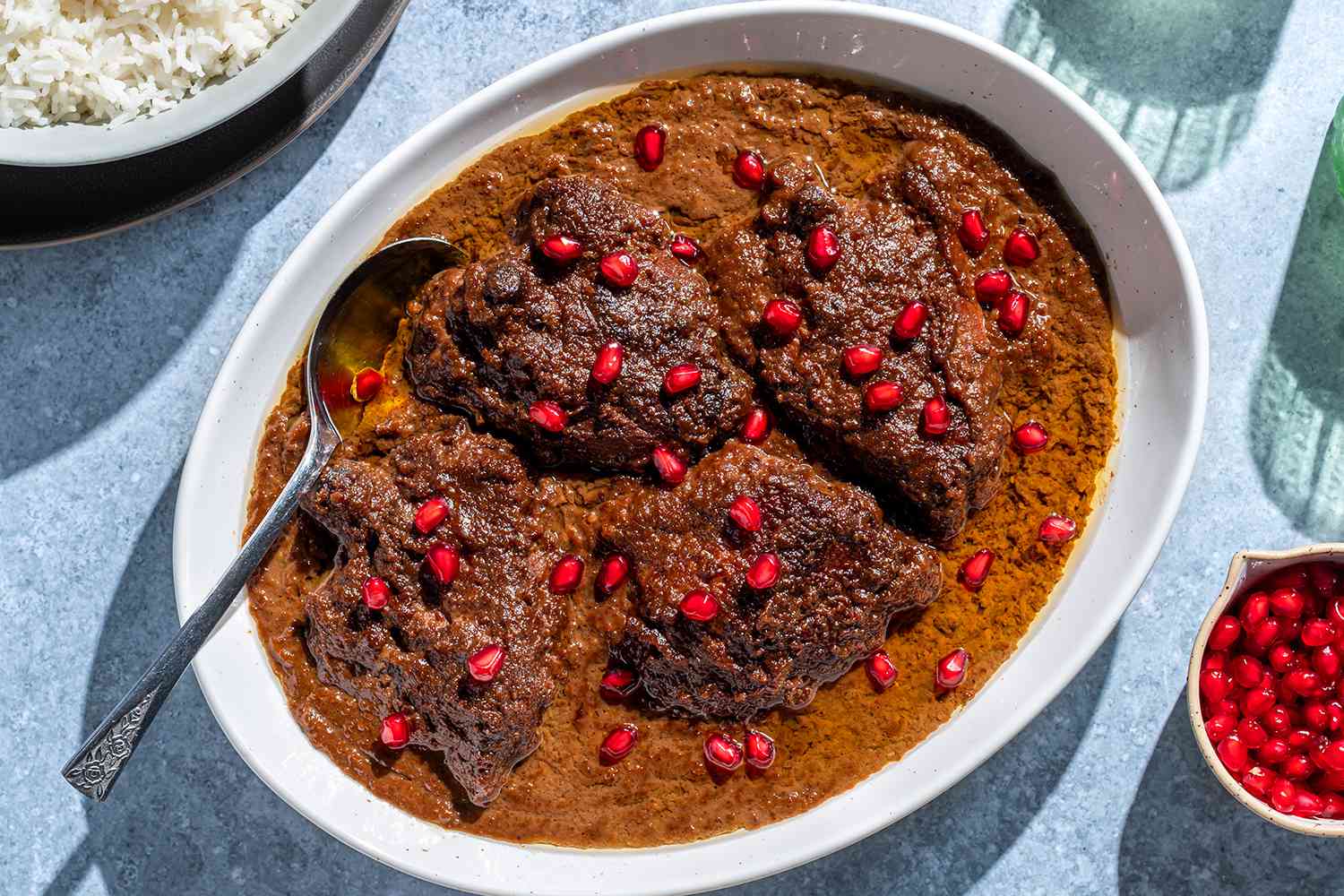vacationhavenhome.com – Fesenjan (also spelled Fesenjoon) is one of the most iconic dishes in Iranian cuisine, beloved for its rich flavor, unique blend of ingredients, and historical significance. This dish, often referred to as a Persian pomegranate and walnut stew, is a celebrated part of both everyday meals and special occasions in Iran. Known for its deep, complex flavors, Fesenjan combines the earthy taste of ground walnuts with the tart sweetness of pomegranate, creating a dish that is both savory and slightly sweet, with a luxurious texture.
The Origins and Cultural Significance of Fesenjan
Fesenjan has ancient roots in Iranian cuisine, with some historians tracing its origins back to the Sassanid era (224–651 CE), one of the ancient Persian empires. The use of pomegranate and walnuts in cooking is deeply ingrained in Persian culinary traditions, and Fesenjan is a dish that showcases the Persian mastery of balancing sweet, sour, and savory flavors in a single pot. It is said to be a dish that Persian kings and nobles enjoyed, and it continues to be a symbol of Iranian hospitality and culinary artistry.
Traditionally, Fesenjan is served during important celebrations such as Persian New Year (Nowruz), weddings, and family gatherings, where it is seen as a dish of honor and abundance. The complexity of its flavor profile makes it a dish that is cherished by many for its balance and depth. While it is commonly prepared with chicken, duck, or even lamb, the dish’s appeal lies in its versatility and ability to complement various meats, making it a universal choice for festive occasions.
Key Ingredients and Preparation
The two central ingredients that define Fesenjan are ground walnuts and pomegranate molasses. These ingredients are blended into a rich sauce that coats the meat and infuses the dish with its signature sweet-sour flavor.
1. Walnuts:
Ground walnuts are the foundation of the sauce, contributing a smooth, creamy texture and a deep, earthy flavor. The walnuts are usually toasted before being ground, which enhances their flavor and makes them richer. This step is essential for developing the dish’s signature thickness and texture.
2. Pomegranate Molasses:
Pomegranate molasses (known as “rob-e-anar” in Persian) is the other star of the dish. It is made by reducing pomegranate juice into a thick, syrupy consistency. The molasses has a tart, tangy sweetness that balances the richness of the walnuts. Its acidity helps cut through the heaviness of the dish, making Fesenjan a complex and satisfying meal. In addition to pomegranate molasses, fresh pomegranate seeds are often added at the end for a burst of fresh, juicy sweetness.
3. Meat:
While Fesenjan can be made with a variety of meats, chicken is the most common choice in modern Iranian kitchens. Duck and lamb are also traditional options that lend their own unique flavors to the dish. The meat is first browned and then simmered in the walnut and pomegranate sauce until it becomes tender and infused with the sauce’s flavors.
4. Onions and Spices:
Onions are sautéed to form the base of the stew, adding depth to the flavor. Iranian cooks often season Fesenjan with spices such as turmeric, cinnamon, and cardamom, which further enhance its aromatic complexity. The careful use of these spices helps to create a harmonious blend of sweet, sour, and savory notes.
Cooking Fesenjan: The Process
The preparation of Fesenjan is an art form in itself. The key to making the perfect Fesenjan is to balance the flavors carefully, and the process usually involves the following steps:
- Sautéing the onions: The onions are finely chopped and sautéed in oil until golden brown. This caramelization brings a deep, sweet flavor that serves as the foundation of the stew.
- Cooking the walnuts: Ground walnuts are added to the onions and cooked together to release their oils and intensify their flavor. This step is crucial for creating the stew’s rich, creamy texture.
- Adding the pomegranate molasses: Pomegranate molasses is then added to the pot along with a bit of water or broth. The mixture is simmered, allowing the flavors to meld together.
- Simmering the meat: The meat (often chicken) is browned separately and then added to the pot, where it is simmered in the walnut-pomegranate sauce until tender. This slow cooking allows the flavors to penetrate the meat and develop a deep, satisfying richness.
- Finishing touches: The stew is typically garnished with fresh pomegranate seeds and sometimes a sprinkle of cinnamon. The stew is then served with saffron rice, a classic accompaniment to many Persian dishes, which adds a vibrant color and delicate fragrance.
Serving Fesenjan: A Feast for the Senses
Fesenjan is typically served with steamed white rice or saffron rice in a traditional Persian style. The rice serves as the perfect complement to the rich, savory sauce, soaking up the flavorful juices and balancing the dish’s complexity. In Iranian culture, a meal is more than just the food itself; it is about sharing and connecting with loved ones. Fesenjan, with its luxurious flavor and celebratory significance, is a dish that embodies this ethos of hospitality, often served to guests with great pride.
The dish’s appeal lies in its complexity — the interplay of flavors from the pomegranate and walnuts, the depth of spices, and the tender meat creates a meal that feels both comforting and indulgent. The combination of savory and sweet flavors in Fesenjan is a hallmark of Persian cuisine, where balance is key, and every dish is crafted to delight the palate.
Fesenjan Beyond Iran
While Fesenjan is quintessentially Iranian, its influence extends beyond Iran’s borders. It is a dish that has been embraced by many in the Persian diaspora, particularly in countries such as the United States, Canada, and Germany, where large Iranian communities reside. In these places, Fesenjan has become a beloved dish for both home cooks and restaurateurs, offering a taste of Persian culture to new generations and curious eaters.
Moreover, variations of Fesenjan can be found in other parts of the Middle East, particularly in Azerbaijan and Turkey, where the use of walnuts and pomegranates is also prevalent in the culinary traditions. In these regions, Fesenjan may be served with different meats or garnished with regional ingredients, but the essence of the dish — its luxurious, tangy sweetness — remains the same.
Conclusion: The Timeless Elegance of Fesenjan
Fesenjan is more than just a dish; it is a reflection of the rich cultural heritage and sophisticated flavors of Persian cuisine. With its historical roots, balanced flavor profile, and cultural significance, it remains a dish that is not only cherished in Iran but also celebrated globally. Whether served at a grand family gathering or enjoyed as a comforting weeknight meal, Fesenjan represents the heart of Iranian culinary tradition — a perfect harmony of flavor, texture, and culture, prepared with care and shared with love.





